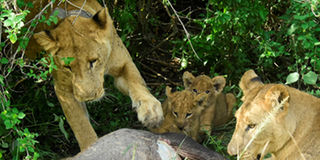Museveni asks communities, partners to conserve wildlife

Wildlife. Lions feast on their prey at Queen Elizabeth National Park. President Museveni has asked Ugandans and the conservation partners to continue supporting government efforts to conserve wildlife heritage. PHOTO BY ROBERT MUHEREZA
President Museveni has asked Ugandans and conservation partners to continue supporting government efforts to conserve wildlife heritage for sustainable development of the country.
Uganda on Tuesday joined the rest of the world to commemorate World Wildlife Day aimed at raising awareness about the world’s fauna and flora.
The national celebrations at Saza Ground in Kisoro District were held under the theme “sustaining all wildlife in Uganda for benefit of the present and future generation.’
President Museveni in a speech read for him by minister of Tourism, Wildlife and Antiquities, Mr Tom Butime, said Uganda hosts 54 per cent of the world’s remaining population of mountain gorillas and 11 per cent of the world’s recorded species of birds (50 per cent of Africa’s bird species richness).
He said the country hosts 7.8 per cent of the global mammal diversity, 19 per cent of Africa’s amphibian species richness and 14 per cent of Africa’s reptile species richness; 1,249 recorded species of butterflies and 600 species of fish.
Mr Museveni, who commended various partners for their efforts in conservation of wildlife in Uganda, said the country is still faced with challenges such as poaching, illegal wildlife trade and trafficking, human- wildlife conflicts, climate change, invasive species, and limited ecological research.
“As you may know, Uganda is gifted by nature with exceptional wildlife diversity. This diverse wildlife endowment gives us a competitive edge to develop Uganda into a top tourism destination in Africa and globally. We remain fully committed to addressing these challenges. We also need to strengthen the idea of having communities at the forefront of conservation,” he said.
Mr Butime launched a book on the state of wildlife resources in Uganda and the red list of threatened species compiled by the Uganda Wild life Authority.
The chairperson of Kigezi Tourism Cluster, Mr Ivan Mbabazi Batuma, and the Kisoro Woman MP, Ms Rose Kabageni, appealed to the government to fulfill its pledge of tarmacking all tourism roads in Kigezi sub-region.
“During the rainy season, most of the roads leading to the national parks in Kigezi sub-region are cut off and some bridges get washed away thus delaying the tourists from reaching their planned destinations. Roads leading to national parks in the neighbouring country of Rwanda are all tarmacked, making tourists comfortable. We need to see our government walking the talk and fulfilling its pledges of tarmacking the tourism roads,” Mr Batuma said.
President Museveni pledged to tarmac tourism roads in Kigezi during the 2016 presidential campaigns.
The Kisoro District chairperson, Mr Abel Bizimana, proposed that Echuya Forest Reserve, located between Kisoro and Rubanda districts, be turned into a national park as it is a habitat for several monkey and baboon species.
He added that the forest reserve has more than 300 bird species including the highly endangered Grauers Rush Warbler, and unique natural bamboo trees.
Echuya Forest Reserve
“Last year, the district councils of Kisoro and Rubanda passed a joint resolution to turn Echuya Forest Reserve into a national park with an objective of proper conservation of the fauna and flora besides promoting tourism and its associated financial benefits to the government. It is my humble appeal that the government takes up the matter for the good of the future generation,” Mr Bizimana said.
The State minister for Tourism, Mr Godfrey Kiwanda, said communities neighbouring the protected areas have in the last three years received about Shs15.39 billion under the revenue sharing fund arrangement.
He added: “We have not lost any of our gazetted areas in the last one year and we strive to improve the ecological integrity of our protected areas and other critical habitats for our predators.”



